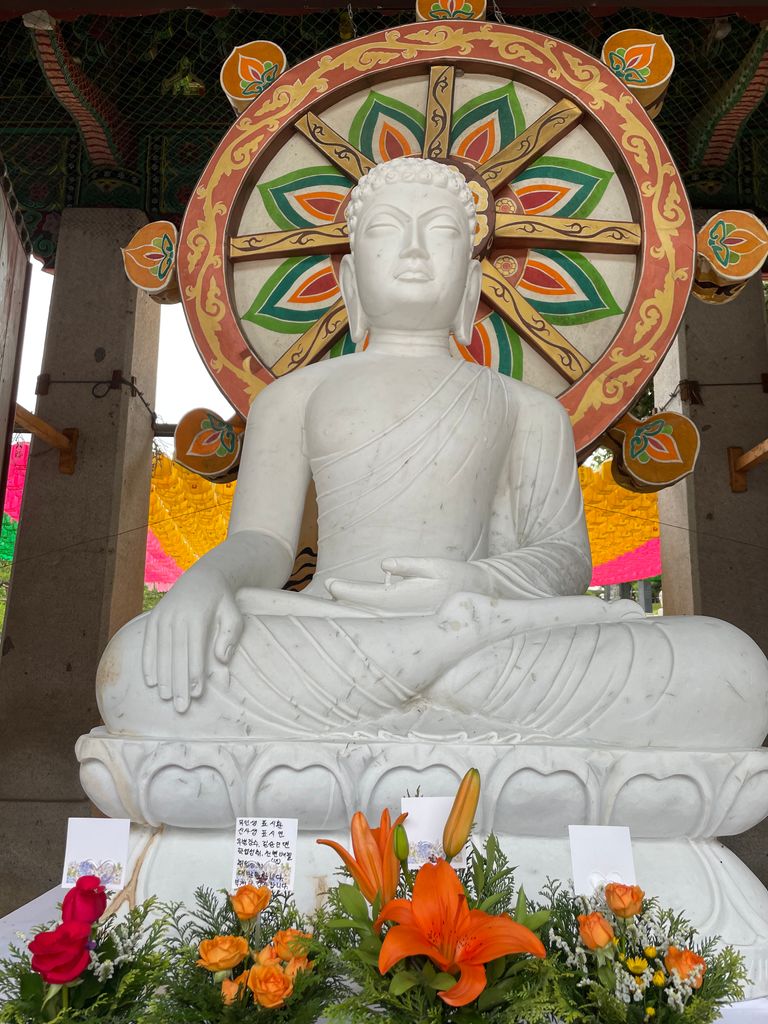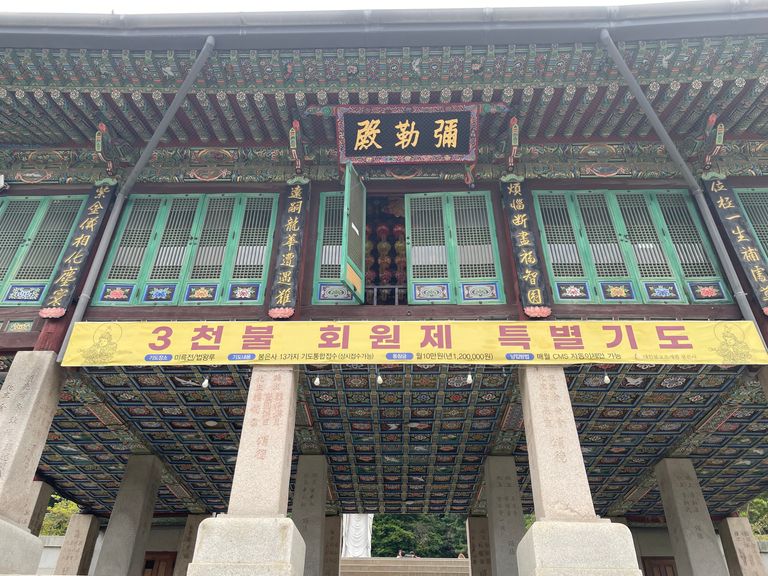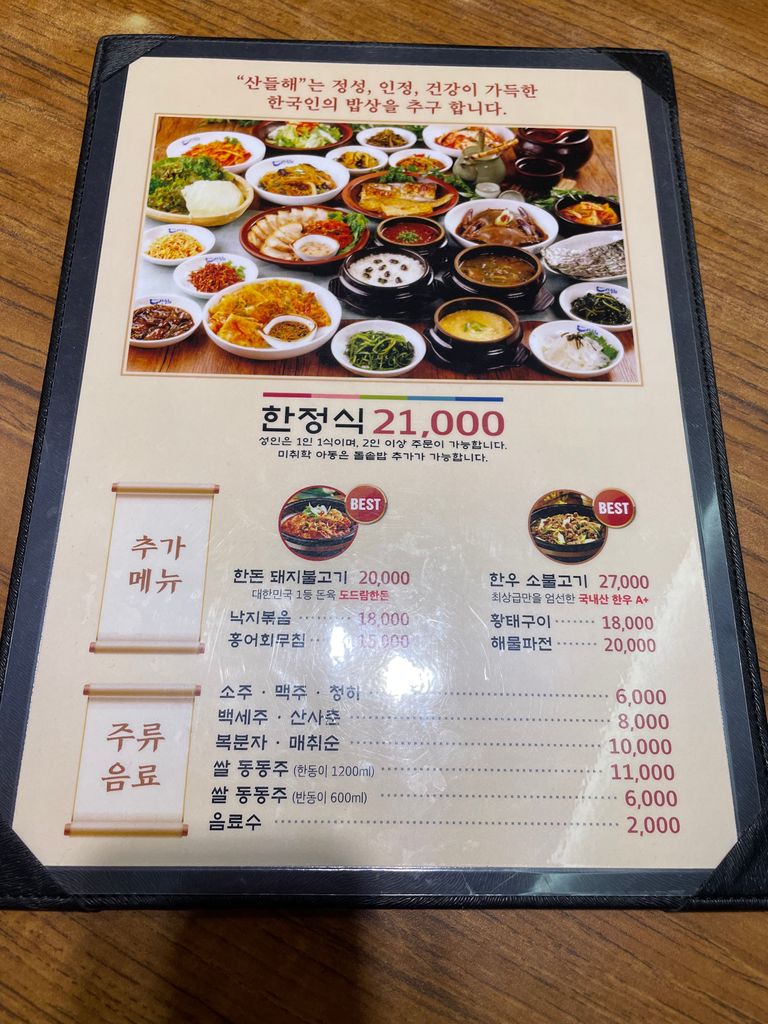
Hello dear community,
now it was time for our first big temple. Not far from our hotel was the Bongeunsa Temple, which of course we could not miss.
In 794, Yeon-hoe, the highest-ranking monk of the Silla period, founded this beautiful Buddhist temple south of the Han River. During the Korean War (1950-1953), most of the buildings in the temple were severely damaged. Therefore, most of the present buildings are from more recent times. In 1902 it became by law one of the 14 main temples in Korea and in 1911 the central temple for about 80 smaller temples in Seoul and the surrounding area. With its history and unusual location in the midst of the ultra-modern and bustling Samseong-dong district, the temple is a sacred oasis of tranquility and a place of pilgrimage for 200,000 Buddhists from around the world each year.
Considered the most important cultural treasure, 3479 wooden block inscriptions with 13 different sutras (sacred texts) are on display in the Panjeon (next to the main temple). At the back of the temple grounds is Mireukdaebul, the tallest Buddha statue in Korea at 23 meters high. It was built over a period of ten years, between 1986 and 1996.
Already at the entrance, the large guardian statues, which guard the oasis of peace with its wonderful gardens, catch the eye. Everywhere are hung lanterns what dips the temple at night in a wonderful light. Unfortunately, we were there during the day and could not experience this. In one of the temple buildings is a huge bell, which you can ring for a donation. This augurs good luck and health.
The paintings on the temples I would call true works of art and everywhere you can feel the history of this wondrous place. We were lucky and were able to experience a live Buddhist service. Such a chance is not so often in life when you come from Europe. Although there were really many people here, it did not feel crowded in any way. And despite the many visitors, there was a pleasant calmness about the temple. Really a great experience.
Since such a temple tour really makes you hungry, we then ended the tour in a nearby Korean restaurant. Of course with traditional Korean delicacies and tea. The table was bursting with small bowls and everyone could try to their heart's content. A culinary treat.
Many greetings and see you soon
Al

Hallo liebe Community,
nun war es also soweit, unser erster großer Tempel stand auf dem Tagesprogramm. Unweit unseres Hotels befand sich der Bongeunsa Tempel, den wir uns natürlich nicht entgehen lassen durften.
Im Jahr 794 gründete Yeon-hoe, der höchstrangige Mönch der Silla-Periode, südlich des Han-Flusses den diesen wunderschönen buddhistischen Tempel. Während des Koreakrieges (1950–1953) wurden die meisten Gebäude im Tempel stark beschädigt. Deshalb stammen die heutigen Bauwerke überwiegend aus neuerer Zeit. 1902 wurde er per Gesetz zu einem der 14 Haupttempel in Korea und 1911 zum Zentraltempel für rund 80 kleinere Tempel in Seoul und Umgebung. Mit seiner Geschichte und der ungewöhnlichen Lage inmitten des hochmodernen und geschäftigen Stadtteils Samseong-dong ist der Tempel eine heilige Oase der Ruhe und Wallfahrtsort für jährlich 200.000 Buddhisten aus der ganzen Welt.
Als bedeutendster Kulturschatz gelten 3479 Holzblockinschriften mit 13 verschiedenen Sutras (heiligen Texten), die im Panjeon (neben dem Haupttempel) ausgestellt sind. Im hinteren Teil des Tempelgeländes befindet sich Mireukdaebul, die mit 23 Meter Höhe größte Buddha-Statue in Korea. Sie wurde über einen Zeitraum von zehn Jahren, zwischen 1986 und 1996 erbaut.
Schon am Eingang fallen wie die großen Wächterstatuen auf, die die Oase der Ruhe mit ihren wundervollen Gärten bewachen. Überall sind Lampions aufgehängt was den Tempel nachts in ein wunderbares Licht taucht. Leider waren wir tagsüber da und konnten das nicht erleben. In einem der Tempelgebäude steht eine riesige Glocke, die man gegen eine Spende zum klingen bringen kann. Dies verheißt Glück und Gesundheit.
Die Malereien auf den Tempeln würde ich als wahre Kunstwerke bezeichnen und überall spürt man die Geschichte dieses wundersamen Ortes. Wir hatten Glück und konnten einen einen buddhistischen Gottesdienst live erleben. So eine Chance bietet sich nicht so oft im Leben, wenn man aus Europa kommt. Obwohl wirklich viele Menschen hier unterwegs waren fühlte es sich in keiner Weise überfüllt an. Und trotz der vielen Besucher lag über dem Tempel eine angenehme Ruhe. Wirklich ein tolles Erlebnis.
Da so eine Tempelbesichtigung wirklich Hunger macht, haben wir die Tour dann in einem nahegelegenen koreanischen Restaurant ausklingen lassen. Natürlich mit traditionellen koreanischen Köstlichkeiten und Tee. Der Tisch war berstend voll mit kleinen Schalen und jeder konnte sich nach Herzenslust durchprobieren. Ein kulinarischer Leckerbissen.
Viele Grüße und bis bald Euer
Al





















Congratulations, your post has been upvoted by @phototalent curation account, use de #phototalent tag